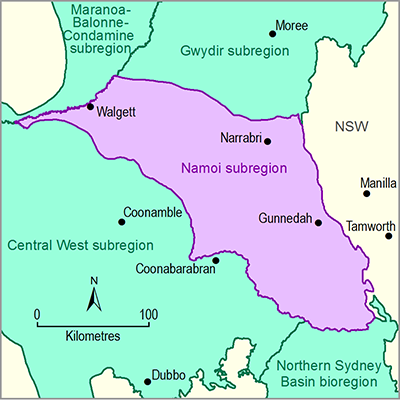Summary
This product summarises surface water accounts in the Namoi river basin for the period 2004–05 to 2011–12. It includes information about major water resources: water stores, flows, allocations, surface water permits and use. Streamflow and water use are the most complete estimates of water availability and use within the water balance and are thus used as the basis for the water account. The Namoi subregion is smaller than the Namoi river basin because the eastern part of the river basin does not overlie a coal-bearing geological basin. The surface water accounts are conducted for the Namoi river basin and not for the subregion because publicly available information on water use is summarised at the basin scale. The Namoi river basin includes the Namoi, Peel and Manilla rivers. Current coal and coal seam gas (CSG) development and exploration are primarily located in the central and eastern parts of the subregion.
There are three large dams (Keepit, Split Rock and Chaffey dams) and a few small dams in the Namoi river basin (but outside the subregion) that supply water to agricultural, domestic and municipal users. The combined storage volume in the large dams is 882 GL. The mean water volume stored for 2004–05 to 2011–12 was 233 GL (26%).
The main surface water resource of the Namoi subregion is the Namoi River. The long-term mean annual flow in the Namoi River at Gunnedah downstream of Keepit Dam is about 620 GL/year whereas at Goangra (46 km upstream of the end-of-system at Walgett) it is about 563 GL/year. The reduction in flow is due to the presence of weirs and surface water diversions mainly used for irrigation as well as instream evaporation and groundwater leakage. About 51% (714 km2) of irrigation in the Namoi river basin is located between Gunnedah and Walgett. The Peel River contributes on average (1973–2011) 235 GL/year to the Namoi River.
The surface water baseline diversion limit was estimated at 508 GL/year whereas the mean annual cap target from 2005–06 to 2011–12 was 241 GL/year, highlighting the recent dry conditions. In the Namoi river basin, total surface water permits amount to 424 GL/year in the regulated sections of the river, of which 1.4 GL/year (less than 1%) are high security, 286 GL/year (68%) are general security, 2.2 GL/year (less than 1%) are for domestic and stock, 19 GL/year (4%) are for local water utilities and 115 GL/year (27%) are supplementary permits. Total surface water permits amount to 117 GL/year in the unregulated sections of the Namoi river basin. The mean annual surface water diverted from 2004–05 to 2011–12 was 278 GL, with 271 GL/year (97%) used in irrigation and 7 GL/year (3%) used for domestic and stock or local water utilities. On average, 84 GL/year of surface water is diverted to agriculture in unregulated rivers. These diversions are unmetered estimates and represent about 30% of mean annual surface water diversions across the basin. Further increase in surface water diversions is restricted under current water plans.
This product also summarises groundwater account data in the Namoi subregion for the period 2006–07 to 2013–14. There are approximately 10,300 licensed bores across the subregion. Approximately 7600 are for stock and domestic water rights, 1401 are for monitoring and exploration of groundwater resources, 983 are for irrigation, 3 are for conservation, and the remaining 309 are for commercial or town water supply extraction.
The mean annual groundwater usage from 2006–07 to 2013–14 was 165 GL/year. The total licensed groundwater extraction volume in 2013–14 was 327 GL/year. However, this includes volumes relating to the entirety of some groundwater sources that only lie partly in the subregion. 252.5 GL/year (77%) was licensed under Aquifer class access licences, 57.7 GL/year (18%) was licensed under Supplementary Water class licences, 16.8 GL/year (5%) was licensed under Local Water Utility class licences and 0.025 GL/year (0.008%) was licensed under Aquifer (Town Water Supply) class licences. The most heavily utilised groundwater sources are the Lower Namoi and the Upper Namoi zones 3, 4, 5 and 8. Groundwater extraction for basic water rights does not require a water access licence, and consequently can only be estimated. Estimated take under stock and domestic rights is 46.4 GL/year.

